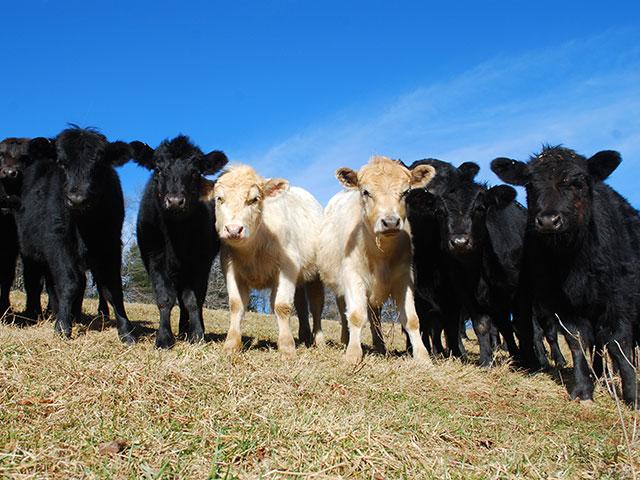Intensive Rotations and Weight Gains
Yearling Steers Gain More in Traditional Grazing Setups
There are a lot of good reasons for intensive grazing rotations, but weight gains may not be one of them.
A newly released study from USDA's Agricultural Research Service (ARS), compared weight gains on cattle in two common grazing systems. The results showed that, on average, there was a 14% reduction in weight gain for yearling steers grazing a managed rotational grazing program across rangeland.
The ranch-scale study, set across more than 6,000 acres, looked at how foraging behavior differed between one large herd rotated among paddocks (collaborative adaptive rangeland management or CARM), versus season-long grazing of paddocks by small, non-rotational herds (traditional rangeland management or TRM).
Research was conducted at the Central Plains Experimental Range area outside of Nunn, Colorado. The lead researcher on the project was David Augustine, based at Fort Collins, Colorado. The work looked at cattle growth rates and diet quality across the two systems. For CARM, decisions regarding annual stocking rates and sequence of timing of cattle movements were made by an 11-member stakeholder group of ranchers.
THE CARM SYSTEM
In the adaptive, controlled rotational grazing system, the researchers reported more linear grazing pathways and lower velocity while grazing. Early in the growing season, grazing periods under this approach were longer. Grazing time was distributed more evenly in years with average or above-average precipitation. Areas of high and low grazing intensity were less spatially clustered, with moving patterns consistent with a less-selective approach to foraging. The "grazing front" moved across the paddock and distributed grazing pressure in a more spatially homogeneous way. In years with substantial forage production, this meant cattle spent less time in preferred areas.
CARM cattle, the researchers found, increased step rates when rotated to a new paddock and for several days following the movement. The increase, however, amounted to less than a 1% increase in total daily energy expenditure, not enough to explain the weight gain declines.
P[L1] D[0x0] M[300x250] OOP[F] ADUNIT[] T[]
Crude protein levels in the CARM diet were significantly lower during the first half of the grazing season, however. This led to the hypothesis that the quality of forage may be reduced due to less selective foraging behaviors, possibly explaining the weight gain difference.
THE TRM SYSTEM
Here, there were less linear grazing pathways, and cattle moved at a higher velocity while grazing. They had shorter grazing bouts early in the season and more uneven grazing time in years with average to above-average precipitation. Areas of high and low grazing intensity were more spatially clustered. Cattle spent more time in preferred areas of the paddocks and foraged in more circular patches.
WEIGHT GAIN DIFFERENCES
From 2014 to 2018, livestock weight gains were 11% to 16% lower each year in the CARM system versus the TRM system. This averaged about 14% over the study.
This meant "significant negative consequences" for net revenue, the researchers reported. They hypothesized the weight gains could be affected by differences in energy expedited in the CARM system, as well as differences in quality/quantity of forage consumed by cattle grazing at a 10-fold greater stocking density in CARM.
Researcher Augustine told DTN that based on prior research, they had expected that a rotation implemented on a fixed schedule would reduce weight gains, but they implemented changes they hoped would mitigate that loss.
"We used an adaptive approach to implementing the rotations where we started the cattle in pastures dominated by cool-season grasses, then rotated them into warm-season grasses based on forage phenology and availability," he said. "We thought this approach might mitigate or eliminate the negative effects of rotation. I was surprised that it did not."
Asked if holding the CARM group a little longer could make up for the lower weight gains, Augustine said that while it is possible, they typically see the highest gains in the first third of the growing season, with growth slowing after that.
"So, it takes longer for them to 'catch up' in late summer, as the forage is senescing," Augustine explained. "Additionally, the ranchers who owned the cattle in our study typically contracted to sell them Oct. 1. They don't have the option of delivering them to the feedlot later without taking a reduced price."
These findings will give producers something to think about, but Augustine said more is coming. They are currently looking at less-intensive rotations to see if reducing stocking density in the herds might increase weight gain to a similar level as that seen in the non-rotational herds.
See the study in its entirety here: https://www.sciencedirect.com/….
Victoria Myers can be reached at vicki.myers@dtn.com
Follow her on Twitter @myersPF
(c) Copyright 2023 DTN, LLC. All rights reserved.






